

Battery design breakthrough brings "dream material" into the mix. One way scientists believe they could greatly improve on the performance of today’s lithium-ion batteries is by introducing lithium metal for use as the anode component.
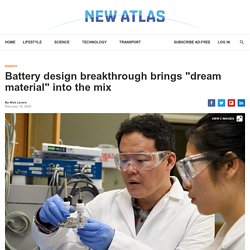
Described by researchers at Washington State University (WSU) as a “dream material,” this would replace current anode materials to give lithium batteries a huge boost, but safely integrating them into the devices has proven problematic. The same scientists have now come up with a way to overcome this hurdle, with a new design that involves a protective layer around the material to prevent it going up in flames. As a lithium-ion battery charges and discharges, lithium ions travel back and forth between the two electrodes, the cathode and the anode. Adaptive micro-pulse tech could drastically reduce EV charging times. It's no secret that many people don't like the limited battery range of electric cars.
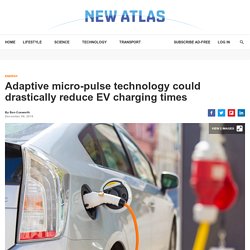
If those batteries could be recharged much quicker, though, that range might not be so off-putting. That's where GBatteries' new pulse-based system comes in – it may one day be capable of safely recharging an EV battery in a matter of minutes instead of hours. In typical charging systems, a consistent current is continuously sent to the battery. That current is increased in fast chargers – this unfortunately degrades the battery over time, decreasing its ability to hold a charge. Additionally, overheating of the battery can occur, potentially even causing fires. Wiesbaden, Germany. Extreme charging temps enable 10-minute refill of prototype EV battery. While Tesla’s latest superchargers can get its customers back on the road quicker than ever before, we’re still a ways off a world where recharging an electric vehicle is akin to a quick fuel stop.
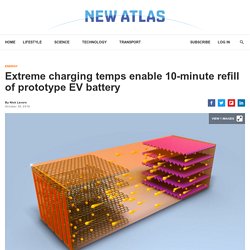
Exciting progress is being made, however, with the latest promising advance coming from chemical engineers at Penn State University, who have built a new battery they say can fully charge an electric car in just 10 minutes. Powering smartphones, laptops, cars and trucks, lithium-ion batteries are hugely versatile and largely reliable, but are delicate systems at the same time. As scientists make subtle tweaks to their design in pursuit of new and improved versions, this often creates other problems, like the formation of dendrites that can cause the battery to short circuit.
Another example relates to the ambient temperatures as the battery is charged. Too cold and the lithium ions will take the shape of spikes on the battery anode. First fully rechargeable carbon dioxide battery lasts 500 cycles. The search for advanced materials that can take battery technology to the next level has led scientists to some imaginative places, including designs inspired by the human spine and others that fashion key components into nanochain structures.
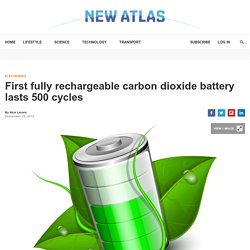
Another example concerns an element we’re producing too much of in carbon dioxide, which scientists have now worked into a high-potential battery with the ability to recharge 500 times. Promising more than seven times the energy density of today’s typical lithium-ion designs, there is considerable interest in the development of lithium-carbon dioxide batteries. And research has turned up some promising results in the past, with a breakthrough we looked at last year from MIT one recent example. That team of mechanical engineers pioneered a new type of electrochemical reaction that increased the discharge voltage and actually converted the carbon dioxide into a solid carbonate material as a result.
Harvard's new organic flow battery uses a long-lived recipe of Biblical proportions. Liquid metal feeds Stanford's new high-voltage flow battery. SiliconX: Scientists hail new alloy as missing ingredient for next-gen batteries. For years, scientists have seen silicon as a hugely promising material in the world of lithium-ion batteries.
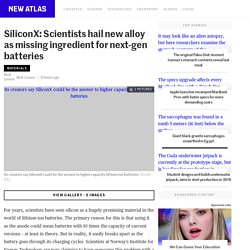
The primary reason for this is that using it as the anode could mean batteries with 10 times the capacity of current versions – at least in theory. But in reality, it easily breaks apart as the battery goes through its charging cycles. Ultra-capacitor hybrid radically boosts power and efficiency of lithium batteries. Combining the unique strengths of lithium batteries with crazy-fast charging, carbon ultra-capacitors could save a ton of weight and add significant range and power to electric vehicles, according to Nawa Technologies.
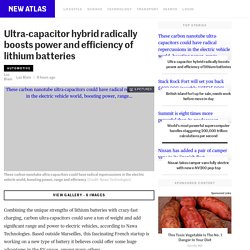
Based outside Marseilles, this fascinating French startup is working on a new type of battery it believes could offer some huge advantages in the EV space, among many others. "3D battery" design twists together for split-second charging. Most batteries are made up of a cathode on one side and an anode on the other, with a nonconducting separator between them.

Now, engineers at Cornell University have developed an unusual new structure that intertwines the components together in a swirling shape, which they say lets the device recharge in a matter of seconds. The Cornell team's new battery architecture is based on a complex, porous shape known as a gyroid, which has previously been used to make the most of the 2D wonder material graphene. Lithium metal battery prototype boasts 3 times the capacity of lithium-ions. The high energy capacity of lithium-ion batteries has led to them powering everything from tiny mobile devices to huge trucks.
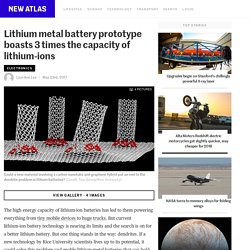
But current lithium-ion battery technology is nearing its limits and the search is on for a better lithium battery. But one thing stands in the way: dendrites. If a new technology by Rice University scientists lives up to its potential, it could solve this problem and enable lithium-metal batteries that can hold three times the energy of lithium-ion ones. Dendrites are microscopic lithium fibers that form on the anodes during the charging process, spreading like a rash till they reach the other electrode and causing the battery to short circuit.
As companies such as Samsung know only too well, this can cause the battery to catch fire or even explode. "Lithium-ion batteries have changed the world, no doubt," says chemist James Tour, who led the study. For a start, it's able to stop dendrite growth in its tracks. Asphalt-lithium metal batteries fully charge in five minutes. As useful and ubiquitous as they are, lithium-ion batteries are nearing their limits, and it's unlikely we'll be able to squeeze much more juice out of them.
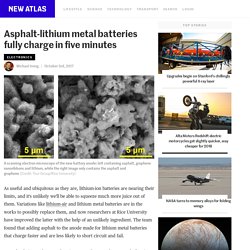
Variations like lithium-air and lithium metal batteries are in the works to possibly replace them, and now researchers at Rice University have improved the latter with the help of an unlikely ingredient. The team found that adding asphalt to the anode made for lithium metal batteries that charge faster and are less likely to short circuit and fail. To make their new battery, the Rice researchers used untreated gilsonite, a derivative of asphalt, and mixed it with conductive graphene nanoribbons. Then, that composite was coated in lithium metal through the process of electrochemical deposition, to create an anode. Building better batteries using crumpled graphene balls.
In the quest to improve on the lithium-ion batteries that power today's mobile devices and electric vehicles, lithium-metal batteries hold a lot of potential.

Although they promise to hold much more energy per charge, they do have shortcomings in their current form, particularly when it comes to safety. Engineers at Northwestern University are now claiming to have overcome these failings by making use of crumpled balls of graphene that fall into line as a scaffold when the battery is charging. "In current batteries, lithium is usually atomically distributed in another material such as graphite or silicon in the anode," explains Northwestern Engineering's Jiaxing Huang. "But using an additional material 'dilutes' the battery's performance. Powering up: The biggest battery breakthroughs of 2017.
Safety first The chances of lithium-ion batteries failing is very low, but with so many of them in use everyday the chances of something going wrong somewhere in the world are very real. Flaming Samsung smartphones and exploding "hoverboards" (we're still reluctant to call them that, but whatever) are evidence of that. Today's batteries already come with chips embedded that track voltage, temperature and the charge they are holding, allowing for warning systems like the one you'll see on an iPhone screen when the handset gets too hot.
But researchers are always looking for ways to keep them cool, and one way of achieving this could be to substitute the combustible electrolyte, the liquid that carries the ions, with something less flammable. Back in 2015, scientists at the University of Maryland and the US Army Research Laboratory came up with a saltwater electrolyte recipe that promised safer batteries for everything from pacemakers to large-scale grid storage.
Solid-state magnesium-ion batteries could lick lithium. Lithium-ion batteries are the undisputed top dog of the battery world at the moment, but magnesium-ion devices have the potential to steal the crown – if scientists can crack the problem of finding an efficient electrolyte. Now a collaboration between Berkeley Lab, MIT and Argonne National Laboratory has developed a solid-state material that appears to be one of the fastest conductors of magnesium-ions, which could lead to safer and more efficient batteries. Lithium-based batteries power everything from phones to electric cars, and while the metal does the job for now, there's plenty of room for improvement in terms of efficiency and price.
Magnesium, on the other hand, has a higher energy density than lithium and is far more abundant in the natural world, meaning devices made with the stuff should be cheaper and easier to produce. The stumbling block to using magnesium in batteries is often the electrolyte, the material that carries the charge between the cathode and anode. Rechargeable zinc-air batteries zero in on lithium. Zinc-air batteries are an enticing prospect thanks to their high energy density and the fact they're made with some of the most common materials on Earth. Unfortunately, those advantages are countered by how difficult it is to recharge these cells. New battery design for electric cars would stack up to 1,000-km range. One of the big stumbling blocks preventing the wide scale acceptance of electric cars is dreaded range anxiety.
With an average range of around 100 mi (161 km) per charge, all-electric vehicles still can't compete with more conventional cars – especially if lights, windscreen wipers, or air con are needed. To level the playing field a bit, Fraunhofer is working on a new battery design that could increase an electric car's range to 1,000 km (621 mi).
Electric cars don't have a single battery, but a collection of battery packs made of hundreds or thousands of individual battery cells that are packed in and wired together. These separate battery cells each require a housing as well as terminals, wiring, cables, and electronic monitors, which all combine to take up 50 percent of the space of a whole battery pack. Additionally, all those electrical connections sap away current through resistance. EMBATT takes its cue from another electrical power source, the fuel cell. Cheap new alloy may double the storage of lithium batteries. Lithium-ion batteries are at the heart of all kinds of devices, from smartphones and laptops to the ever-growing contingent of electric cars. So there is interest from many quarters in boosting their performance with advanced materials that make them lighter, more compact and able to hold more energy.
A new tin-aluminum alloy developed by engineers in Texas might deliver on all three aspects, and it might even make them faster and cheaper to produce at the same time. For years, mass-produced lithium-ion batteries have relied on graphite and copper for their anodes, the component that stores the energy as the battery charges. And for years, researchers have sought out alternative materials that could overcome the limitations of those materials, which include a high cost of production and limited storage capacity (silicon, for example, could store 10 times as much energy, although it poses another set of problems). Sodium-ion battery beats lithium for cost effectiveness. Asphalt-lithium metal batteries fully charge in five minutes.
As useful and ubiquitous as they are, lithium-ion batteries are nearing their limits, and it's unlikely we'll be able to squeeze much more juice out of them. Variations like lithium-air and lithium metal batteries are in the works to possibly replace them, and now researchers at Rice University have improved the latter with the help of an unlikely ingredient. The team found that adding asphalt to the anode made for lithium metal batteries that charge faster and are less likely to short circuit and fail.
To make their new battery, the Rice researchers used untreated gilsonite, a derivative of asphalt, and mixed it with conductive graphene nanoribbons. "Ion highway" electrodes drive development of batteries that charge in seconds. Supercapacitors can charge and release energy much faster than batteries, but they can't store as much. Now a team at Drexel University has used the two-dimensional material MXene to develop a new type of electrode, combining the capacitance of a regular battery with the speed of a supercapacitor, which could lead to devices that recharge in a matter of seconds.
New battery design for electric cars would stack up to 1,000-km range - New Atlas. One of the big stumbling blocks preventing the wide scale acceptance of electric cars is dreaded range anxiety. How recycled glass bottles can become better batteries. Ask a regular smartphone user how they'd like to see the devices improved, and it's a safe bet that longer battery life would be close to the top of the list. Batteries made with silicon anodes could help boost that, and now a team at the University of California Riverside (UCR) has shown that these batteries can be environmentally friendly too, by being sourced from glass bottles headed for the scrap heap. Fern-leaf inspires electrode for high density solar energy storage.
Solar cells are constantly getting better at collecting energy from sunlight, but their ability to store it isn't improving quite as fast. Made from graphene and with a fern-inspired fractal structure, engineers at RMIT University have developed a new prototype electrode that could enable solar harvesting and storage systems that are thin, flexible and have high capacity.
Can the Goodenough lab invent the battery to jumpstart the electric car revolution? Diamonds turn nuclear waste into nuclear batteries. One problem with dealing with nuclear waste is that it's often hard to tell what's waste and what's a valuable resource. Flexible supercapacitor process brings phones that charge in seconds a step closer. Researchers from the University of Central Florida (UCF) have devised a technique for creating flexible supercapacitors that not only store more energy than comparable devices, but can also be fully-charged in seconds and continue to be recharged more than 30,000 times without affecting performance or capacity. "If they were to replace batteries with these supercapacitors, you could charge your mobile phone in a few seconds and you wouldn't need to charge it again for more than a week," said postdoctoral associate Nitin Choudhary. Working in the NanoScience Technology Center at UCF (and building on previous work in supercapcitor nanowire technology), the researchers realized their breakthrough by experimenting with the application of newly-discovered 2D materials known as transition-metal dichalcogenides (TMDs) only a few atoms thick to coat 1D nanowires.
However, like many nascent technologies, the UCF flexible supercapacitor has not yet been developed sufficiently for release to market. The key to better rechargeable batteries may be in your blood. Solid-state lithium battery knows when to keep its cool. Eco-friendly battery gets vitamin B2 boost. Toyota battery breakthrough means magnesium could eventually replace lithium. Adding silicon-sulfur into 3D graphene makes for game-changing battery potential. Power dense zinc-manganese power unit as cheap as a car battery.
Urine-powered battery offers cheap energy source. Experimental battery charges and recharges via bacteria. Lithium-ion battery boost could come from "caging" silicon in graphene. New flow battery projected to cost 60% less than existing standard. "Water-in-salt" battery bodes well for greener, safer grid storage. More hurdles jumped on path to a practical lithium-air battery. "Fool's gold" nanocrystals present cheap, abundant alternative to lithium in batteries. World's first "aqueous solar flow battery" outperforms traditional lithium-iodine batteries. Sugar Powered Batteries. Non-Degrading Electrodes Opens Doors for Wind and Solar Power. Building Batteries from Plant Roots. Porous Lithium-Ion Battery Charges in Ten Minutes.
Battery Stretches to 300 Times its Size. Cheaper Catalysts Build Better Batteries. Cheaper Catalysts Build Better Batteries. Longer-Life Lithium-Sulfur Batteries. Tiny Batteries Recharge Instantly. Edible Battery Leads to Ingestible Medical Electronics. 3D Printed Microbattery. Better Batteries from Crabs. Eco-friendly Wood Sodium-Ion Nanobattery. Everlasting Solar Battery. Membrane-Free Battery Could Encourage Green Energy Use. Curved and Flexible Batteries from LG Chem. Flexible Battery Can be Made at Home. Virus Improves Battery Efficiency. Self-Healing Batteries. 3D Printed Batteries. Rhubarb-Based Organic Battery. Energy-Dense, Refillable Sugar Batteries. Biocompatible Nanodots Significantly Improve Battery Performance.
Better Batteries from Waste Heat. Battery Yarn Could Power Wearable Textiles. Ultra-fast Charging Battery Packs. Organic Battery is Cheap, Clean and Long-Lasting. Sand-Based Battery Outperforms Current Models. Zinc-Based Flexible, Rechargeable Batteries. Cigarette Butts Offer New Energy Storage Option.
Cheaper, Better Supercapacitors Made From Hemp. Recycling Tires into Better Batteries. All-Liquid Battery Could Make Alternative Energy More Attractive. World's First Solar Battery is Powered by Air and Light. Using Holes to Build a Better Battery. Disposable Cardboard Mini Power Batteries. Organic flow battery could transform renewable energy storage. Flexible, fast-charging aluminum-ion battery offers safer alternative to lithium-ion.
New water-based organic battery is cheap, rechargeable and eco-friendly. New li-ion battery anode could charge electronics in minutes. New "dual carbon" battery charges 20 times faster than Li-ion. New device combines the advantages of batteries and supercapacitors. Packing peanuts could be reused in better batteries. High-performance flow battery could rival lithium-ions for EVs and grid storage. Going small with silicon potentially has big implications for lithium-ion battery capacity. World's first solar battery claimed to "run on light and air" Long-lasting, water-based nuclear battery developed. Stable lithium anode may triple battery efficiency. New water-based organic battery is cheap, rechargeable and eco-friendly.
Proton flow battery simplifies hydrogen power. Sugar batteries could be greener, cheaper and store more energy than lithium-ions. Wood nanobattery could be green option for large-scale energy storage. All-solid lithium-sulfur battery stores four times the energy of lithium-ions. Silicon nanoparticles used to create a super-performing battery. Hybrid self-charging power cell by-passes batteries. Graphene paper anodes pave way for faster charging Li-ion batteries. Electrochemical flow capacitor: Hybrid battery-supercapacitor design targets grid storage.
IBM looking to put lithium-air batteries on the road. Another zero-emissions powerplant emerges - the Dearman Engine runs on liquid air.